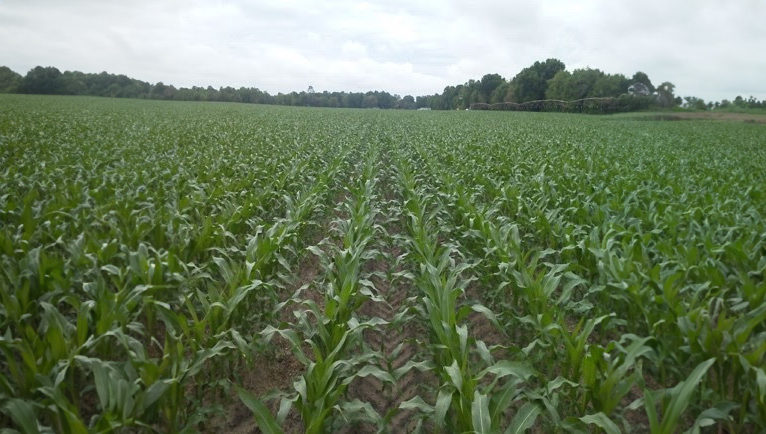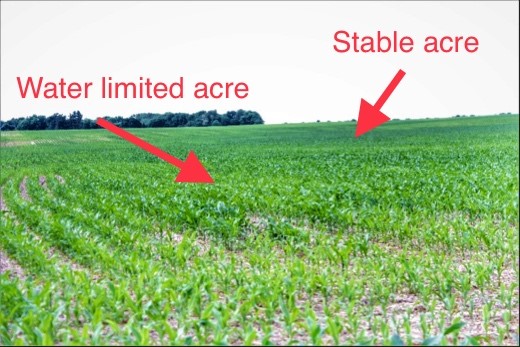Finding ways to support the crop through dry conditions
Across the Corn Belt today, a measurable rain has been hard to come by and conditions are very dry. While the resulting plant stress is causing a great deal of personal stress for growers, it’s important to remember that, historically, this water-limitation occurs on roughly 30% of our acres each and every year. This year, unfortunately, it’s impacting more than just our traditionally drier environments. We know that every day after planting, the ability to supply nutrients to our crops declines due to lack of moisture. What does that mean for us this year and, ultimately, what can we learn from it to help guide our management decisions moving forward?

Why Early Moisture Matters: Fueling Corn Growth and Nutrient Movement
When the planters unfold and make their first passes, the soil moisture content is as high as it will ever be in that given year on many acres. We know we need moisture for a multitude of reasons. The corn seed needs to absorb roughly 30% of its weight in water just to start the germination process. Once germinated, the corn plant is not autotrophic, or self-sustaining, quite yet. Therefore, it is entirely dependent on energy generated from the seed to emerge. As the radical root and seminal roots develop after emergence, the plant starts to get a “sense” for what its environment has available for its development and starts to take in nutrients slowly. At the V3 stage, the corn plant becomes autotrophic and now is dependent on photosynthesis for energy. It also must utilize its root system to uptake nutrients via diffusion. This is where water once again becomes paramount. Diffusion is a process where nutrients in high concentration (soil) move to areas of low nutrient concentration (root zones) and this can only be done in the presence of moisture. Moisture is also needed at this same growth stage to promote mass flow for the uptake of nitrogen and sulfur primarily. At Advanced Agrilytics, we emphasize the importance of “the race to canopy”. By utilizing our spatial approach where we focus on tailoring each environment to maximize potential, our goal is to achieve crop canopy in 30-45 days in all environments. We understand the moisture available at planting is something we need to use to our advantage, and it starts with making sure we have the nutrients we need readily available to the plant from the beginning.

Starter Nitrogen: A Stronger Foundation Starts with Understanding each Acres Behavior
In these current conditions, the value of starter fertilizer often comes to the surface. While the use of starter may spark debate among growers, its core importance lies in combining nitrogen and sulfur with ample moisture, providing the building blocks to propel plant growth, establishing a strong nutritional foundation. We’re seeing significant variability and stress in today’s crop because of the absence of ample moisture and lack of nutrient on acres that didn’t receive additional support prior to or at planting. In terms of the nutrients needed, potassium and many of the other essential elements are not required at this early growth stage. Plants require more phosphorus when conditions are cold or wet. Nitrogen, however, is required in almost any weather or environmental scenario and in larger amounts to V6. Therefore, we must take full advantage of soil moisture and nitrogen availability to support a growing crop, specifically on acres that do not have the mineralization that others have.
The understanding of acre behavior and tendencies is critically important when conditions aren’t favorable. Consider these two scenarios that are common: the stable acre, or the acre that often receives the final water deposition after a rainfall, versus the water-limited acre. The stable acre has adequate moisture, better soil structure and mineralogy and often grows the best crop. This is because we have an increased rate of diffusion of nutrients, better root mass, more than likely a greater organic nitrogen contribution, among other things. It tends to grow a viable and thriving crop and does so year after year. But, what about the tendencies of the water limited acre? Most years, at some point our lighter soils on knobs (higher elevation, lower organic matter, etc.) lose moisture. Which, in turn, leads to a decreased rate of diffusion, decreased root mass development, decreased nitrogen uptake, and ultimately a decreased opportunity to get to canopy in a timely manner. As a result, it has the tendency to slow growth and ultimately “burn up” due to sunlight penetrating the soil surface and reflecting upwards to the bottom of our leaves.

Proactive Moisture Management at Planting
Growers should consider ways to exploit each acres’ tendencies, using this knowledge to develop a proactive management strategy that can increase our chances of getting to canopy in a timely manner. Ensuring a field is fit for planting is a good first step in that effort, meaning a good seed bed and planting into adequate moisture. The biggest sin of spring is planting into unfit conditions. Growers planting in wet conditions often must pay for that decision all year. Secondly, nutrients need to be available at planting for the plant to utilize at its earliest opportunity with adequate amounts of those nutrients available to sustain increased crop growth until the next opportunity for application. This sets us up for winning the second quarter of the growing season, getting the crop to V6. In a year like this year, this has been a crucial strategy to implement because of how quickly we turned dry prior to side dress. Advanced Agrilytics is working with growers daily to help make decisions necessary to support the 2023 crop, all while already strategizing for the 2024 growing season. In our next article, we’ll share some key learnings about nitrogen application and proactively thinking through what else the crop will need to finish this season strong.
As we move through or beyond the sidedress season, reflecting on crop observations made from the tractor cab will lead to better crop management in future seasons.
To learn more about about nitrogen application opportunities, especially in water-limited environments, check out our next article.
Visit the website at advancedagrilytics.com to find your local agronomist or keep up with our latest agronomic news.